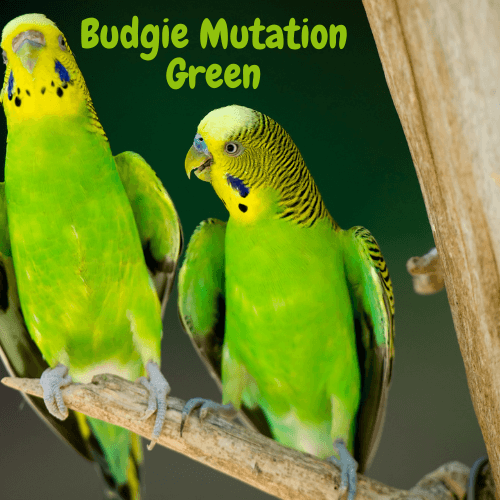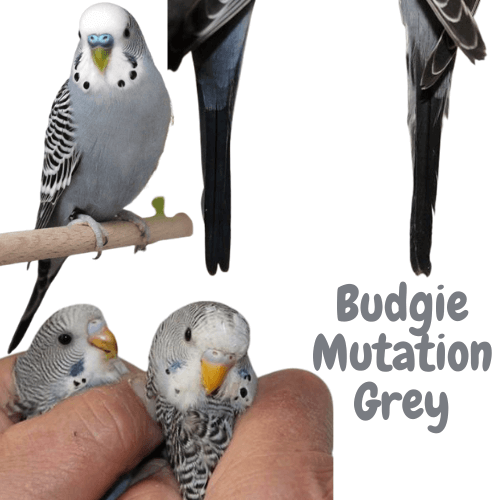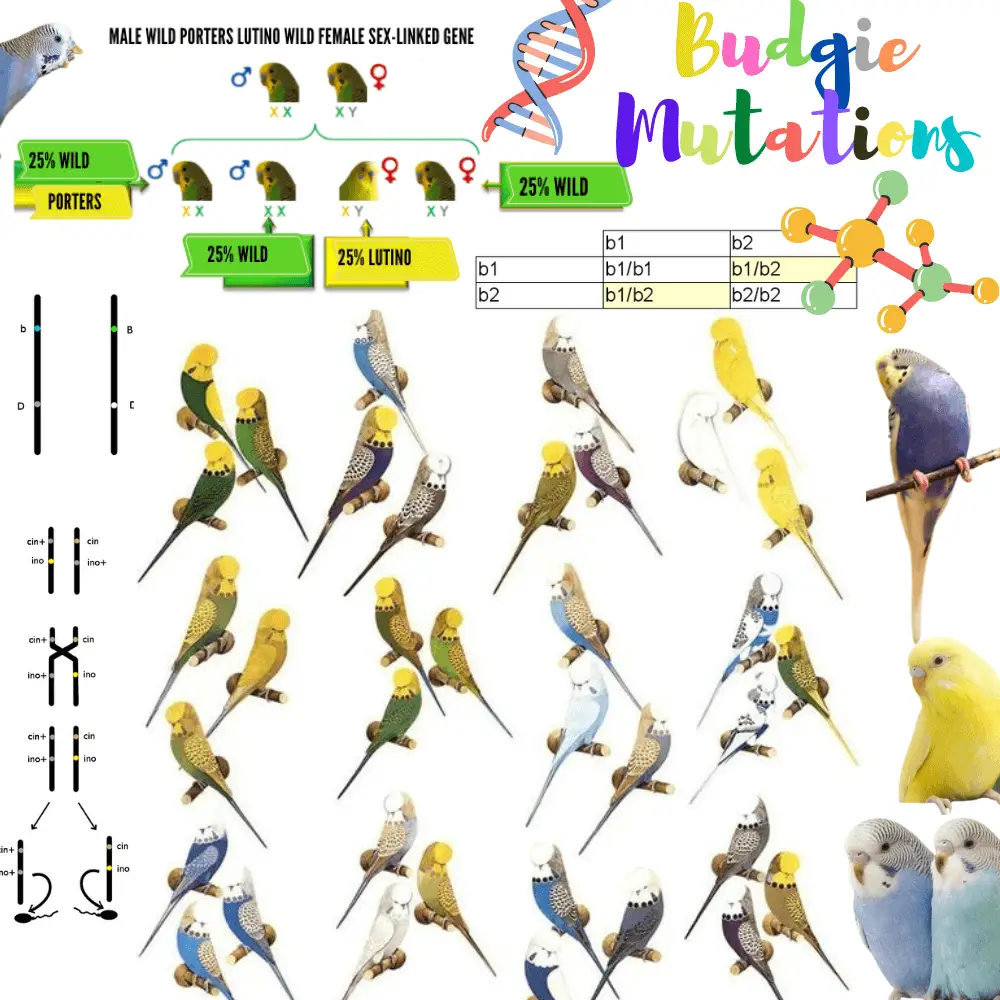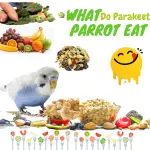
There are many kinds of wild budgie mutation also named green mutation: light green=wild type, dark green, and olive green. This is the dark factor that will affect the budgie color of the budgie’s body. If there is 0 dark factor it gives a green or light green, bright color. If there is 1 dark factor it gives a dark green darker green and if there are 2 dark factors it gives an olive green dull and deep color, olive green as the name suggests.
Scientific name: Melopsittacus undulatus Order: Psittaciformes
Family: Psittacidae
Genus: Melopsittacus
Origin: Australia (arid and semi-arid region)
Size: 18cm
Lifespan: 8 to 15 years
Budgie mutation green

Recognizable by the light green of the body, the yellow head, the black undulations on the back, and a bluish tail, green is the wild phenotype of the budgie Parakeet simply because it is the color found in the wild. However, it is important to note that the green parakeets that can be seen in the exhibitions come from birds bred and selected for generations on the farms. It is also rare to be able to certify having “pure” greens since a bird can be a carrier of a recessive mutation that can remain silent for several generations until a carrier individual is mated to a partner with the same recessive gene.
The Budgie is native to Australia. Parakeets live in eucalyptus forests or in the Australian bush, most often in groups. Indeed, it is possible to observe imposing flocks of parakeets or to see a large number of them come to drink. They nest in cavities dug into tree trunks.
Many mutations have appeared thanks to selection in farms and the standard has evolved but they have still kept the Australian biological clock since it is possible to breed them in the fall, time of spring in Australia.
Green is one of the background colors. It makes it possible to work on a lot of mutations to avoid too many mixtures of mutations. For example, a green parakeet can be mated to a diluted one to obtain diluted carriers that can then be crossed with diluted ones to obtain young mutants.
Especially if the bird is a blue carrier and the partner to which it is mated is a blue or blue carrier, it is possible to get young in both the green and blue series. Certainly, green is a classic color and easily found in aviary aviaries but it is rare to be blown away by a beautiful standard parakeet. Not so simple as it seems to get beautiful green!
Budgie mutation blue

The blue mutation is easily recognizable since, as its name suggests, the bird has a light blue body and a white mask by the disappearance of the yellow pigments of the wild phenotype. It only affects the color, there is no change in the melanin of the ripples or the drawing so just like the wild phenotype, the bird has black ripples on the back.
This is one of the background colors with green but also gray and gray-green that will be discussed in a future publication. This makes it possible to distinguish two series: the green series with all the mutations having as background color green or green-gray (cinnamon green, pallid gray-green, lutino…) and the blue series with all the mutations including the bird as background color blue or gray (diluted blue, Australian magpie gray, albino …).
Blue is a recessive mutation, that is to say, both parents must have the gene to obtain young blues. For me, the best mating of other bird mutations is a blue carrier green mated to a blue to get young of both series.
If the genotype of a green bird is not known, it is preferable to mate it to a blue mutation partner either to have young blue carriers for the next generation or if the green is a blue carrier to obtain blue young and green blue carriers.
The mating ♂️ green carrier blue x ♀ green carrier blue carrier also possible to obtain young of both series but on the other hand, it does not allow to certify if the young greens obtained are blue carriers because it is possible to obtain young green carriers but also young green non-carriers because the father.
The parents each have the green factor rated V and the blue factor rated B. Blue being recessive, the bird must have two B factors to be mutant, i.e. to be blue. If it has only one factor B then it is a carrier. During gene transmission, the parents are both BV (green-blue carriers), there are therefore several possibilities:
♀️ Factor transmitted by the mother
♂️ Factor transmitted by the father
♀️ V + ♂️ V = VV
♀️ V + ♂️ B = VB
♀️ B + ♂️ V = VB
♀️ B + ♂️ B = BB
That is 25% young non-carrier greens, 50% blue carrier greens, and 25% blue
It is possible to redo this pattern with all the matings between green and blue (mutant or carrier) to determine the young that will be obtained. In short:
♂️ carrier green blue x ♀️ blue (or vice versa)
50% green blue carrier
50% blue
This mating remains in my opinion the one to favor to obtain young of both series except in some cases if you want to obtain only young green series or only blue series. In the latter case, two birds of the blue series must be mated together. This is what I do for example with cinnamon because I have a preference for cinnamon blue.
Budgie mutation grey

Gray is an additional factor in addition to either green or blue, so grey is expressed in both series. In the green series, we talk about gray green while in the blue series, we simply talk about gray. Gray and gray-green are both background colors.
Grey Grey Green
Greys should not be confused with dark factors including double factors, sometimes there is confusion between gray-green and olive green or between gray and purple. Greys, whether grey-green or grey, have greyish-blue ear spots and a matte-black tail (whereas dark postmen have purple-blue ear spots and a purplish-blue tail). The differences are illustrated in the photos below.
Left: purple (purple blue ear spots)
Right: grey (greyish blue ear spots)
Left: purple (purplish blue tail)
Right: grey (matte black tail)
Grey, like other dominant mutations, can be a single or double factor. It is not possible to tell the difference with the naked eye between SF gray and DF gray. The only way to determine this is through the transmission to young people as we will see below.
Note G is the mutated allele of the gray gene so which gives gray and g the non-mutated allele of the gray gene. An SF gray is, therefore, Gg (since it is a single factor only one allele is mutated) while a DF gray is GG (since it is a double factor two alleles are mutated).
♀ Factor transmitted by the mother
♂ Factor transmitted by the father
Consider that in the following matings, the partners are both blue series so all the young are also blue. We do not deal with the transmission of the blue gene which is recessive but only with the transmission of single or double-factor gray.
♂ SF Grey (Gg) x ♀ Blue (gg)
♀ g + ♂ g = gg
♀ g + ♂ g = gg
♀ g + ♂ g = gg
♀ g + ♂ g = gg
That is 50% young SF grays and 50% blues
♂ DF Grey (GG) x ♀ Blue (gg)
♀ g + ♂ g = gg
♀ g + ♂ g = gg
♀ g + ♂ g = gg
♀ g + ♂ g = gg
That is 100% young SF grays
When gray is a double factor, it is possible to realize it if we only get gray in its young because all will inherit a gray factor.
To obtain DF gray youngsters, two at least single-factor greys must be mated together and then the young greys must be tested with a partner with no grey factor to determine whether they are a single or double-factor.
♂ SF Grey (Gg) x ♀ SF Grey (Gg)
♀ G + ♂ G = GG
♀ G + ♂ g = Gg
♀ g + ♂ g = gg
♀ g + ♂ g = gg
That is 50% young SF grey, 25% DF grey, and 25% blue.
The mating of two DF grays (GG) would only give DF grays since there would be only one possibility of transmission: the mutated G allele by the mother but also by the father.
Other mutations are concerned with the single and double factor. Some also do not have a visual difference like purple. Others have, in addition to the difference through genetic transmission, a distinction in phenotype. For example, the Australian magpie DF has much less variegation than an Australian magpie SF or the pearl DF which no longer shows any pearls unlike the pearl SF but is a yellow bird with black eyes (green series) or white with black eyes (blue series) or dark factors.
Budgie Mutation Dark Factors

There are different shades for the basic colors (green, blue, gray, and gray-green), these are the dark factors. These shades are not visually detectable in gray or gray-green birds and yet the genes can be passed on to offspring.
In the green series, we distinguish light green, dark green (1 dark factor), and olive green (2 dark factors). In the photo below from left to right: light green – dark green – olive green (body color diluted by the pallid mutation).
In the blue series, we differentiate light blue, cobalt (1 dark factor), and purple (2 dark factors). In the photo below from left to right: cobalt – purple – light blue.
A bird with one or two specimens of dark factor has purple-blue ear spots and a purplish-blue tail, which makes it possible to differentiate between duplicate dark factors and gray and gray-green.
The dark factor is denoted D for dark factor in English which is also found in the new name of mutations in wavy:
Light green = green
Dark green = D-green
Olive green = DD-green
Light blue = blue
Cobalt = D-blue
Purple = DD-blue
Factor transmitted by the mother♂
Factor transmitted by the father ♀
Consider that in the following matings, the partners are both blue series so all the young are also blue. We do not deal with the transmission of the blue gene which is recessive but only with the transmission of the dark factor in single or double copies. The dark factor is denoted D and the non-mutated allele is d.
Cobalt (Dd) x ♀ Blue (dd) or conversely d + D = Dd ♂ ♂♀
♀d + ♂ d = dd
♀ d + ♂d = dd
♀ d + ♂d = dd
That is 50% young cobalt and 50% blue
♂ Blue (dd) x ♀ Purple (DD) or vice versa
♀ D + ♂ d = Dd
♀ D + ♂ d = Dd
♀ D + ♂ d = Dd
♀ D + ♂ d = Dd
That is 100% young cobalt
Cobalt (Dd) x ♀ Cobalt (Dd) D + D = DD ♂♂♀
♀ D + ♂ d = Dd
♀ d + ♂ d = dd
♀ d + ♂ d = dd
That is 50% young cobalt, 25% purple, and 25% blue
The dark factors of the blue series make it possible to work on the visual purple that we will see in the next article. It all depends on what you want to get as young but several matings like the ones above are possible to get the different shades.
Let us take the case of gray and gray-green with dark factors not visible to the eye but involved in the transmission of young people. The gray factor is denoted G and the allele is not mutated g.
♂SF grey with 1 dark factor (Gg Dd) x ♀ Blue (gg dd)
♀ g d + ♂ G D = Gg Dd
♀ g d + ♂ g d = gg dd
♀ g d + ♂ G d = Gg dd
♀ g d + ♂ g d = gg Dd
That is 25% young SF gray with 1 dark factor (not visually detectable), 25% blue, 25% SF gray without dark factor, and 25% cobalt
Obtaining young cobalt in this mating while the blue female has no dark factor, therefore, makes it possible to deduce that the male has a dark factor that does not cause any nuance in its gray color. There is therefore no real interest in working a bird with a dark factor in single or double copy with a gray or gray-green partner.
Budgie mutation purple

A visual purple parakeet is actually a blue bird with a purple factor, either single or double factor, and a dark factor in a single copy.
If the bird has only the violet factor and no dark factor, it is a purple-blue whose color resembles that of cobalt with however some purple reflections that reveal the presence of the violet factor. If the bird has a purple factor and a dark factor in duplicate, it is a purple that looks very much like a purple except for some purple reflections thanks to the purple factor.
Left: purple (body color brighter than purple thanks to purple reflections)
Right: blue-violet (some discreet purple feathers at the neck)
I thought this male was cobalt but the cobalt x purple mating should have given me purples, but I never had any so I concluded this male is actually purple-blue.
Several matings make it possible to obtain violets. We’ll see a few of them below. Both partners are blue series so the youngsters are all blue series equally. The violet factor is denoted V (v for the non-mutated allele) and the dark factor D (d for the non-mutated allele). An SF purple corresponds to Vv and a DF violet to VV, cobalt to Dd, and a purple to DD.
♀ Factor transmitted by the mother
♂ Factor transmitted by the father
♂ Purple SF (Vv Dd) x ♀ Blue (vv dd) or vice versa
♀ v d + ♂ v d = vv dd
♀ v d + ♂ v d = vv dd
♀ v d + ♂ V d = Vv dd
♀ v d + ♂ v d = vv dd
That is 25% SF violet (Vv Dd), 25% cobalt (vv Dd), 25% SF violet blues (Vv dd), and 25% blues (vv dd).
♂ Purple SF (Vv Dd) x ♀ Cobalt (vv Dd) or vice versa
♀ v d + ♂ v d = vv dd (purple)
♀ v d + ♂ V d = Vv dd (violet blue)
♀ v d + ♂ v D = vv Dd (cobalt)
♀ v d + ♂ v d = vv dd (blue)
♀ v D + ♂ V D = vV DD (purple purple)
♀ v D + ♂ V d = Vv Dd (purple)
♀ v D + ♂ v D = vv DD (purple)
♀ v D + ♂ v d = vv Dd (cobalt)
That is 25% SF violet, 25% cobalt, 12.5% SF purple, 12.5% SF purple, 12.5% purple, and 12.5% blue.
♂ Violet SF (Vv Dd) x ♀ Violet (Vv Dd) or vice versa
♀ V D + ♂ V D = VV DD (purple purple DF)
♀ V D + ♂ V d = VV Dd (purple DF)
♀ V D + ♂ v D = Vv DD (purple SF)
♀ V D + ♂ v d = Vv Dd (purple SF)
♀ v d + ♂ v d = vv dd (purple SF)
♀ v d + ♂ V d = Vv dd (SF violet blue)
♀ v d + ♂ v D = vv Dd (cobalt)
♀ v d + ♂ v d = vv dd (blue)
♀ V d + ♂ V D = VV Dd (purple DF)
♀ V d + ♂ V d = VV dd (violet blue DF)
♀ V d + ♂ v D = Vv Dd (purple SF)
♀ V d + ♂ v d = Vv dd (SF violet blue)
♀ v D + ♂ V D = Vv DD (purple purple SF)
♀ v D + ♂ V d = Vv Dd (purple SF)
♀ v D + ♂ v D = vv DD (purple)
♀ v D + ♂ v d = vv Dd (cobalt)
That is 25% SF violet, 12.5% DF violet, 12.5% SF violet blue, 12.5% SF purple, 12.5% cobalt, 6.25% DF purple, 6.25% purple, 6.25% blue, and 6.25% DF violet blue.
This mating offers a great possibility of combinations so it is not necessarily the best choice if you do not want to get all these mutations. The advantage is to obtain purple DF or purple DF blues which would then make it possible to make 100% purple couplings. However, an SF violet is not visually distinguishable from a DF violet so it will only be possible to determine it with the young obtained since a DF violet gives 100% of young people with a violet factor.
♂ Purple SF (Vv Dd) x ♀ Purple (vv DD) or vice versa
♀ v D + ♂ V D = Vv DD (purple purple SF)
♀ v D + ♂ V d = Vv Dd (purple SF)
♀ v D + ♂ v D = vv DD (purple)
♀ v D + ♂ v d = vv Dd (cobalt)
That is 25% SF violet, 25% cobalt, 25% purple, and 25% SF purple.
With the matings we saw above, it is not possible to get a majority percentage of purples. There are still several matings that have not been detailed, for example with a blue-violet or purple-purple partner.
It is possible to repeat this pattern of transmission with other matings, the main one being to understand the logic: one SF violet will transmit the SF violet factor to 50% of its young, two SF violets will transmit the violet factor to 75% of the young (50% in SF and 25% in DF), a DF violet will transmit the SF violet factor to 100% of its young and two DF violets will transmit the DF violet factor to 100% of the young youths.
It remains to add the dark factors since it must be remembered that a visual purple is a bird with a purple factor (either SF or DF) but also a dark factor in a simple factor.
The advantage of mating 2 SF violets together is to get young DF violets that will always transmit a purple factor to their young so a possibility to get even more violets in the young. The coupling of 2 violets DF makes it possible to obtain 100% violets.
There are several matings that make it possible to obtain only young purples but it is still necessary to have the breeders. Since a visual purple is a cobalt with a violet factor, the only possibility to obtain 100% visual violets is to have a partner who has the dark factor in duplicate so that he transmits one to each of his young without the other partner having a dark factor so as not to obtain purple (dark factor in duplicate).
Regarding the transmission of the violet factor, it is necessary that at least one of the two partners has the violet factor in duplicate to obtain 100% of yellows with the dark factor. The other partner may not have a purple factor or have an SF or DF violet factor, this will influence the percentage of SF and DF violets obtained in the young.
Mating to get 100% young purples:
♂ Blue x ♀ Purple DF or vice versa (100% purple SF)
♂ Violet blue DF x ♀ Purple or vice versa (100% purple SF)
♂ Violet Blue DF x ♀ Purple Purple SF or vice versa (50% purple SF and 50% purple DF)
♂ SF Purple Blue x ♀ Purple DF or vice versa (50% SF purple and 50% DF purple)
♂ Violet Blue DF x ♀ Purple Purple DF or vice versa (100% Purple DF)

It is, therefore, necessary to first try to obtain birds with this phenotype with the matings seen above and then to make these matings giving 100% violets.
The purple factor can be expressed in the green series. A green with a purple factor is called purple green and looks like a dark green with some purple feathers, especially at the rump which is however completely absent in dark green. A dark green with a purple factor looks like an olive green always with some purple feathers on the rump.
Visually, the purple factor in a green serial bird is nowhere near as impressive as visual purple since it goes rather unnoticed. However, purple-green should be used more often, although mating with a blue-bearing purple-green reduces the number of violets obtained in the young, to improve the intensity of the violet, and make it even brighter.
Even if there are some small differences between purple-green and dark green, purple-green is not necessarily easy to detect so it is best to make a mating to get your own young purple greens.
The mating of a light green bird with a purple partner gives only young of the green series but all blue carriers (unless the green is a blue carrier, in this case, there will be young of both series): greens, purple greens, dark greens, and dark purple greens.
The problem with this mating is that it allows both purple greens and dark greens that will sometimes be difficult to distinguish. The best would then be to mate a green with a purple-blue to get only young greens and purple greens that would be easier to differentiate, provided of course to have a purple-blue bird and not cobalt.
Once the blue purple-carrying green is obtained in the first generation, it is possible to make the matings we saw above, the only difference being that there will not only be blue series birds but both series.
Top 10 Budgie Colors, Varieties & Mutations
SOURCE: Salvador Budgie




















